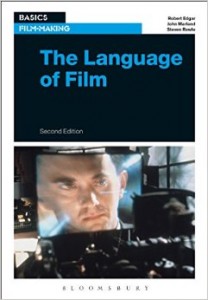Basics of Filmmaking: The Language of Film by John Marland, Robert Edgar-Hunt and Steven Rawle (AVA Academia, 2010), pages ISBN: 978-2940411276 (paperback), £19.95
About the reviewer: Eddie McMillan is Programme Director for the M.A. Film and Digital Video Production in the Department of Media, Art and Design at Canterbury Christ Church University. He has worked as an editor, sound designer, director, producer and cameraman and has taught film, video, multimedia and photography. He is involved in a number of the courses the Department runs, with particular responsibility for teaching film and video production and editing theory and practice. A founder member of the Powell Research Group, he has been active in promoting, researching and archiving the work of Michael Powell and the Archers. His research interests include film and video production particularly editing theory and practice, photography, film noir, Michael Powell, exploitation and cult cinema and Jacobean tragedy.
 Academia’s ‘Basics Film-Making’ series continues with The Language of Film, a text that seems to be predominantly targeted at film students and those with an interest in how film communicates meaning to its audiences. The book attempts to cover a wide range of topics from semiotics to concepts of narrative, genre, aesthetics and practical filmmaking. While, it is almost impossible to distil such a complex concept as the language of film into manageable ‘bite size’ pieces, the authors have managed to present ideas in a straightforward and uncomplicated manner. The book consists of six chapters: Semiotics, Narrative, Intertexuality, Ideology, Frames and Images, and Constructing Meaning. Each chapter explores its topic efficiently with a summary of the main issues and pointers for further study.
Academia’s ‘Basics Film-Making’ series continues with The Language of Film, a text that seems to be predominantly targeted at film students and those with an interest in how film communicates meaning to its audiences. The book attempts to cover a wide range of topics from semiotics to concepts of narrative, genre, aesthetics and practical filmmaking. While, it is almost impossible to distil such a complex concept as the language of film into manageable ‘bite size’ pieces, the authors have managed to present ideas in a straightforward and uncomplicated manner. The book consists of six chapters: Semiotics, Narrative, Intertexuality, Ideology, Frames and Images, and Constructing Meaning. Each chapter explores its topic efficiently with a summary of the main issues and pointers for further study.
Layout and design are attractive and there are plenty of film images to augment the academic dialogue. Where the text is particularly successful is in the information presented alongside the academic discourse. Sidebars are used resourcefully to explain key words and phrases and outline concepts linking wider cultural aspects to the cinematic text, which will invite the engaged reader to explore the topic in more detail. There are also exercises designed to get the reader closely involved in analysing the moving image and to consider the various components that constitute film production and, in turn, the meanings created through the language of film. Each chapter includes a case study that is detailed and explores key concepts related to a particular context. Discussion questions are provided to facilitate analysis and help tutors create debate. The further reading section for each chapter is effective in suggesting texts for supplementary study and research. The glossary is also a welcome addition for the novice student or casual reader.
... this book will really benefit students and staff is in its accent on the relationship between theory and practice
Where this book will really benefit students and staff (as an educational tool) is in its accent on the relationship between theory and practice. This interchange is increasingly seen as necessary to a fully rounded understanding of how cinema communicates its meanings and is essential in situating production within a critical and theoretical context. The strength of the text is that both practitioners and academics can use it to explore the concept of film language in relation to the creation and understanding of meaning. For practical students, Basics Film-Making: The Language of Film will help them to contextualise their work in theoretical terms allowing for the integration of practical and theoretical considerations. Similarly, for theory students the text allows for an understanding of the production process and the impact this has on the creation of meaning and therefore analytical discourse. This combination of theory and practice within the text should enable students to produce practical and theoretical work that is informed by, and contextualised within, relevant theoretical issues and debates.
Overall, the book works well as an introductory text outlining the main concepts relevant to the concept of film language, how it communicates and how these meanings are created and suggested through the cinematic process.
Eddie McMillan